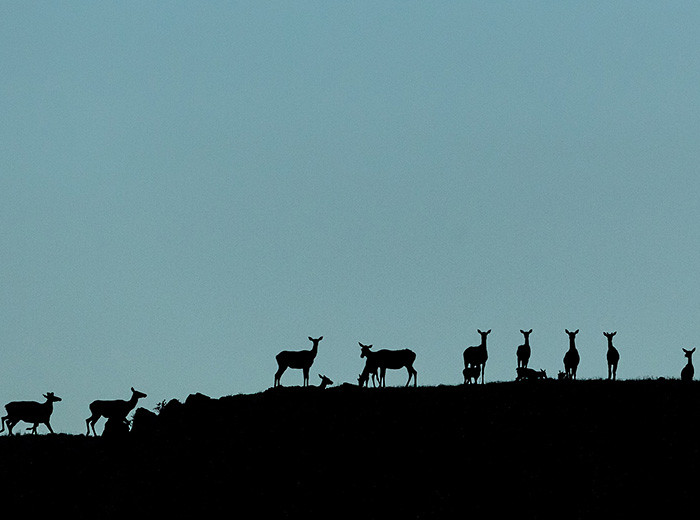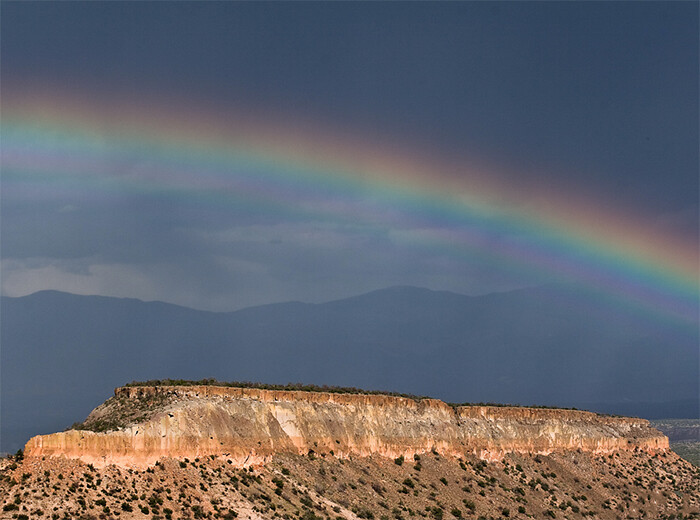“Painting” nature one frame at a time

Doug Coombs
On any given weekend, you might find Lab software engineer Doug Coombs in the outdoors, snowshoeing in the mountains in the winter, hiking above Los Alamos in the summer or even patiently waiting by the marshes in the fall at Bosque del Apache as huge flocks of sandhill cranes and other birds take to the air at dawn.
“I’ve always loved the outdoors, and I love the scenery that surrounds me,” says Coombs. “Bringing along a camera lets me capture some of that scenery so that others can hopefully see what I see.”
“Painting” scenery and wildlife
Doug was in middle school when he first discovered photography, basically by helping a friend work in his darkroom. Intrigued, he found some books on photography in his parent’s house. It was then that he developed an interest in black and white photography, something he explored during his college years. When cameras went digital, Doug decided to try them out and found that he loved them. Today, he shoots with Canon 5D Mark IV and Canon 7D Mark II digital cameras with an assortment of lenses.
Doug views photography as a creative process. “Photography is how you see things—how you envision them in your mind,” he explains. “If you have great hand-to-eye coordination, you would likely interpret what you see through painting. My hand-to-eye coordination isn’t that great, so I would make for a poor painter. However, photography is my creative outlet, because it has enabled me to ‘paint’ scenery and wildlife through proper lighting, positioning, and creative interpretation. When a photo comes out great, it satisfies me creatively.”

An example of how Doug Coombs uses lighting to create a stunning composition. He took this photo at Yellowstone National Park.
Shooting Landcapes
When it comes to photographing landscapes, Doug notes that lighting and location are two key considerations. They typically require patience and planning.
“There are certain times of day when the shadows hit a landscape just right, and you simply have to wait for those moments,” he says about the importance of patience when it comes to proper lighting. “Ideal times for shooting are early in the morning or later in the afternoon because the sun is low, the shadows are long, there’s more contrast and colors are not washed out."
Discovering intriguing landscapes is no easy feat, and Doug notes that such endeavors take some planning. “When it comes to shooting landscapes, the most interesting subjects are often in difficult-to-access locations,” Doug says. “The United States has a number of wildlife refuges, among them Bosque del Apache and the Rio Grande Nature Center. I have discovered others, and I intend to explore more.”
Photographing birds: capturing the glint
Although Doug enjoys photographing all types of wildlife, particularly mammals, he has discovered an affinity for photographing birds.
“I love capturing animals in motion,” he says. “My principal subjects are birds, typically because they are the easiest to find.”
Doug says that the best photos of birds capture their eyes up close. “I have been fortunate to have made some shots where I have captured the glint in a bird’s eye,” he says.
To photograph birds in flight, Doug breaks down his approach to that of anticipation. “You learn to take notice of when a bird tenses up before flight,” he explains. “The smaller birds move so quickly that it’s difficult to catch them, but over the years I have learned to anticipate even their movements so that I can get good action shots. Positioning also plays a role. You try to position yourself so that the bird will fly toward you so that you have more time to catch the bird within your camera’s frame.”

Doug Coombs captures a bird ready to take flight. Notice the glint in the bird’s eye.
A stunning example
Although he has taken some formal classes in photography, Doug has learned mostly on his own and through several fellow photographers. To continue his education in photography, he runs the Los Alamos Photography Club. Open to all with an interest in photography (primarily digital), club members meet on the first and third Tuesdays of most months from 7 to 9 p.m.
Doug’s skill has led to some rather stunning images. One such image was perceived as unbelievable.
“I used to display my work at Fuller Lodge Art Center,” Doug explains. “There was one photograph I had taken at the Monterey Aquarium through the glass of an outdoor aquarium. The fish were underwater and surrounded by bubbles from the aerator. An Art Center employee told me that during a show, when I was showcasing that photo, a patron absolutely insisted I must have ‘photoshopped’ that image. In fact, I had only developed it normally; it was a case where I looked at the scene with a photographic eye and noticed what a casual observer probably wouldn’t: intermittent sunlight passing through the side and sparkling off the bubbles as they shimmered while floating to the surface surrounding the fish like a translucent curtain.”
For Doug, all it takes is a camera and the patience and persistence to capture the right moment.

A beautiful New Mexico landscape from Doug Coombs.






